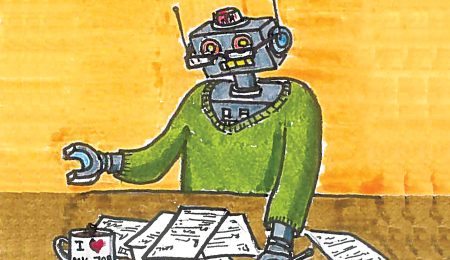It is time to re-frame how we use technology in education–let’s start with digital literacy.
On dark winter mornings, few things feel as daunting as abandoning your cozy bed to make the trek across campus in the cold… all for an 8:30 a.m. lecture. Thankfully, the pandemic brought about one significant change in higher education: bimodal classes. By allowing students to attend lectures either in person or via Zoom, universities have introduced much-needed flexibility into student life.
Bimodal classes seem like the ideal solution for students juggling illness, long commutes, or sheer exhaustion. There are several advantages to bimodal classes; yet, students rely on the professor’s technological expertise to ensure they receive the full benefits.
The promise of accessibility is often undermined by technical issues, such as poor audio quality, challenges with video sharing, and difficulty facilitating discussions for online participants. These problems highlight a larger issue: the gap between available resources and effective use of technology in education.
According to Alain St-Amant, vice-provost of academic affairs, professors are not without support. “The Teaching and Learning Support Services (TLSS), when a new technology comes out, they give workshops on it. For example, when YuJa and Wooclap came out, they gave workshops on how to use them. Once something is an established technology, it would be one-on-one support,” he told the Fulcrum in an interview.
However, St-Amant also noted there is no mandatory tech training for new professors. While resources exist, the lack of structured guidance can result in inconsistent application of these tools.
This inconsistency is exacerbated by the way technologies are used. Take PowerPoint presentations, for instance. These are typically designed for in-person learning and rarely translate seamlessly to an online environment; in contrast, asynchronous learning materials—crafted specifically for online consumption—tend to face fewer challenges.
St-Amant observed, “the asynchronous online courses have made university studies possible for people who need to work a full-time job during the day, an older population who wants to return to studies.”
So, as technology continues to evolve faster than ever, a pressing question emerges: how can universities maintain the quality and integrity of education in a digital age?
I propose creating mandatory training (similar to those provided on academic integrity) on digital literacy. Digital literacy, broadly speaking, refers to the ways students engage with online content. This type of literacy poses unique challenges such as using different search engines, navigating results and assessing the reliability of sources. Primarily, assessments of digital literacy should consider how to engage critically with new learning technologies.
As we have learnt with generative AI large language models (LLMs), such as ChatGPT, machines that learn human behaviour also generate human mistakes such as biases and inaccuracy. MIT’s Sloan Management Review describes “a more effective approach must assist users with identifying the parts of AI-generated content that require affirmative human choice, fact-checking, and scrutiny.”
Mandatory digital literacy training could empower students to understand these limitations and develop the skills to navigate them effectively.
Collaboration should be one of the focuses of this training. Universities must anticipate technological challenges by involving students in the conversation. Training sessions should not merely dictate best practices, but invite feedback on how new tools impact learning. Such dialogue will foster a culture of curiosity and skepticism rather than blind trust in new technology—a necessary mindset for navigating an increasingly digital world.
The common counterargument cites that exposing students to new technologies risks diluting their learning experience. Critics argue students might rely on technology instead of acquiring foundational skills.
Digital literacy training should reflect the pace of technological change. On the topic of innovation, WIRED states “having an end-to-end view doesn’t mean you’ll follow a perfect path – an experimental mindset is part of development, after all.”
Encouraging students to critique, question, and test the capabilities of technology will deepen their understanding rather than diminish it. Incorporating digital literacy training into university curricula is essential. Current students will become the workforce of tomorrow that will work closely with all these new technologies.
It’s up to educational institutions to prepare students for that reality. Training that emphasizes critical thinking, creativity, and adaptability will help students gain a competitive edge while preserving the core values of education.
It’s time to reframe how we use technology in the classroom. Digital literacy training offers a path forward—one that fosters innovation, and ensures universities remain places of learning.






